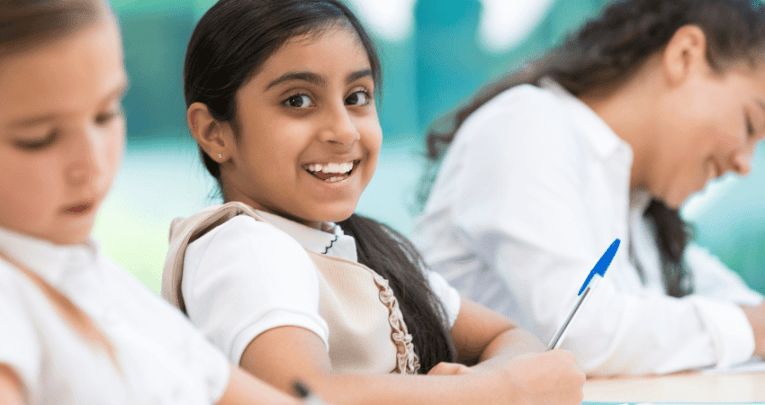Ashley Booth reading – 400+ fully resourced KS2 lessons

This free download offers comprehensive and structured reading lessons for KS2…

- by Ashley Booth
- Year 6 teacher and AHT

This Ashley Booth reading curriculum download contains a fully resourced and planned reading curriculum for KS2. It includes over 400 lessons – approximately 100 for each year group from 3 to 6.
Each lesson is based around a short text. These are often included, but sometimes you will need to source the text yourself before the lesson.

Click below to access the downloads:
- Year 3: part 1 / part 2 / part 3 / part 4
- Year 4: part 1 / part 2 / part 3
- Year 5: part 1 / part 2 / part 3
- Year 6: part 1 / part 2 / part 3
Find out all about teacher Ashley Booth’s approach to teaching reading below.
Ashley Booth reading curriculum
We have a 45-minute whole-class reading lesson every day. This consists of around 15 minutes of children reading, then 30 minutes of discussion and tasks.
We also read our class novel for 15 minutes every day (separate to our reading lesson) and study this book on Monday and Friday.
This ensures children have access to and study a text in its entirety from start to finish. They build the skill of following a text through.
We also use these lessons to focus on the skills of prediction and summary as these are better applied to the entirety of a text.
Linked texts
I’m not a fan of studying just one book all the time (though I know many schools do it well and achieve fantastic reading cultures and results). However, if I do this I feel I can’t guarantee that children are getting a strong diet of poetry, non-fiction and picture books.
So our Tuesday, Wednesday and Thursday lessons are for ‘linked texts’ – three texts that sit well together. They may run on from each other and be linked in terms of theme (World War 2 or Ancient Greece, for example) or they may link together through genre (three days of excellent poetry, for example). My colleagues and I have planned 36 groups of linked texts for each year group.
The texts get more challenging as the children get older. This might be more complex syntax or deeper themes. The type of questioning, however, largely stays the same.
Classic texts
Each year group studies classic texts for two weeks a year. This includes:
- Charlotte’s Web and Stig Of The Dump – Year 3
- The Lion, The Witch and The Wardrobe – Year 4
- The Jungle Book and Peter Pan – Year 5
- Holes, Dickens and Treasure Island – Year 6
Poetry
Each year group also studies classic poetry for two weeks a year. This includes:
- Matilda Who Told Lies – Year 3
- Chocolate Cake and Life Doesn’t Frighten Me At All – Year 4
- The Walrus and The Carpenter, The Highwayman and The Listeners – Year 5
- The Raven, Ozymandias and The Jabberwocky – Year 6
Picture books
Each year group also studies picture books for two weeks a year. It’s vital that all year groups get access to the best picture books, such as:
- The Tunnel and The Day The Crayons Quit – Year 3
- Varmints and How To Live Forever – Year 4
- The Fantastic Flying Books Of Mr Morris Lessmore and The Wolves In The Walls – Year 5
- The Arrival and Can I Build Another Me? – Year 6
Science
We’ve mapped out science topics across the year group. Year 3 learn about forces, focusing on magnetism. For this reason they learn about the legend of Magnes the Shepherd and the discovery of magnetism. We also use Egg Drop by Mini Grey and the story of Isaac Newton and the apple to give them an appreciation of gravity.
When Year 3 do light, they look at the poem My Shadow by Robert Louis Stevenson. At the end of the poem, a young boy goes out before the sun is up and references the fact that his ‘lazy shadow’ has stayed in bed. This is a true chance to apply scientific knowledge.
To complement life cycles in Year 5, children study the lyrics to Circle Of Life. While it might not be steeped in science, it’s a fun accompaniment, with the chance to apply knowledge.
There’s lots of important non-fiction embedded across these weeks too. Year 6 learn about how burglar alarms work when studying electricity (but also do the song Wires by Athlete).
Thomas Edison is looked at in Year 4. Year 5 study Margaret Hamilton and Dorothy Vaughan while doing space.
History and geography
These are already reading-rich subjects. We supplement things like Middle Eastern countries with The Breadwinner and some non-fiction on how beautiful the Middle East is.
We supplement an Ancient Greece topic with a recipe for moussaka. For population in Year 6 we use the fabulous Uno’s Garden and compare the density of Monaco to the sparsity of Russia.
We supplement civil rights with Sam Cooke’s A Change Is Gonna Come and Maya Angelou’s The Caged Bird.
PSHE
We’ve built in some links to PSHE. For example, there’s a week on equality in Year 5 where children learn about Clara Zetkin and Cesar Chavez. There’s also a week on money in Year 4 where children learn how money is made and look at two different examples of money struggles:
- Brother Can You Spare A Dime – this is about a man who lost everything in the Great Depression
- It’s A No Money Day by Kate Milner
Year 6 work on resilience using Peter H Reynold’s The Dot and Drive by Incubus.
Quality fiction
We do two weeks of novels per year group – books that it would be a shame for children to miss out on.
Struan Murray’s Orphans Of The Tide and Thomas H Taylor’s Malamander are modern texts but allow for deep analysis and are really fun for the children to read.
Children are also exposed to Wonder (Year 5), Mortal Engines (Year 6) and Fortunately, The Milk (Year 3). We’ve also included diverse texts such as Little Badman and the Killer Aunties, The Gauntlet and The Girl Who Stole an Elephant.
Individual authors
We’ve also thought about the importance of studying one author for three days to make comparisons across their writing:
- Roald Dahl, Anne Fine, Dick King-Smith, Philip Reeves and Sarah McKintyre – Year 3
- Jennifer Killick and Guy Bass – Year 4
- Michael Morpurgo and Frank Cottrell Boyce – Year 5
- Katherine Rundell – Year 6
Songs
Songs are poetry. They are brilliant to pick apart. We use Disney songs and other examples too, such as:
- Fight Song, Count On Me, My Lighthouse – Year 3
- Cat’s In The Cradle – Year 5
- Both Sides Now by Joni Mitchell, Sia – Year 6
People
This includes the likes of:
- Bessie Coleman – Year 3
- Frida Kahlo and Howard Gayle – Year 4
- Lillian Bader and Tim Burners Lee – Year 5
- Alan Turing and Kitty Wilkinson – Year 6
Making it individual
We’re based in Liverpool, so throughout our whole curriculum you’ll see lots of examples of references to the city. We learn about the Industrial Revolution and its impact on Liverpool. When studying the Titanic we look at its link to Liverpool. We link a Beatles song to the book Beetle Boy. When looking at unusual habitats, we read about dolphins in the River Mersey.
Ashley Booth is a Year 6 teacher and phase, maths and reading lead. He is passionate about improving reading. Visit his website.






